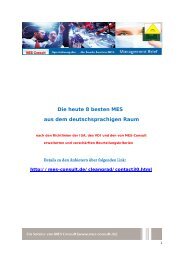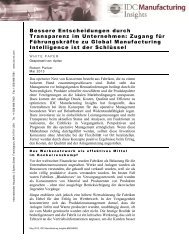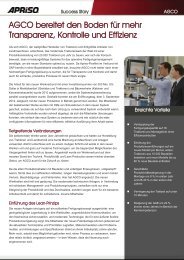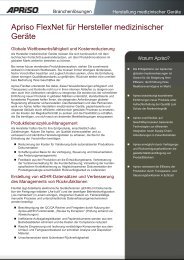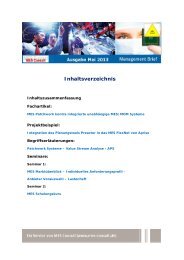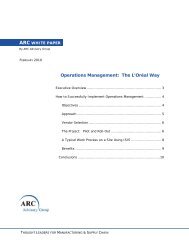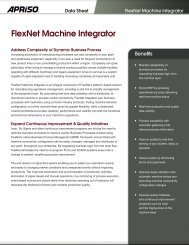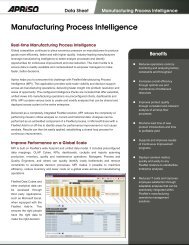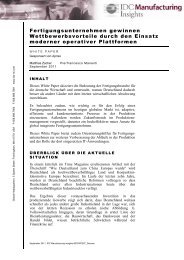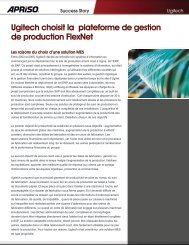Collaboration - Apriso
Collaboration - Apriso
Collaboration - Apriso
Create successful ePaper yourself
Turn your PDF publications into a flip-book with our unique Google optimized e-Paper software.
18<br />
Collaborative Environments in<br />
Manufacturing Operations continued<br />
Siemens (www.siemens.com)<br />
Siemens offer to manufacturing operations is TIA – Totally Integrated Automation – covering all<br />
aspects of automation and control. For Siemens, TIA ranges from the sensor, actuator and local<br />
controller level to the interfaces between factories, warehouses, transportation and business systems.<br />
Siemens offers capability across the entire spectrum, from supply of automation components to<br />
taking project responsibility for global automation projects.<br />
Siemens has observed increasing demand for active collaboration. Tight integration between ERP<br />
and factory systems optimises what, when and how to produce. But today’s manufacturers are<br />
moving further, to create collaborative environments to ensure they can react to every unexpected<br />
event, every change in requirements, and every new opportunity. Siemens supports this requirement<br />
by providing rule-based interaction among different systems and reaction in real-time to any<br />
condition on the plant floor. These automated systems create a unified information base and timely<br />
triggers to guide manufacturing operations people in any role, in any location to work together to<br />
solve problems and respond to new requirements.<br />
A key Siemens offering in this range is SIMATIC IT, which fits the category of ‘manufacturing execution<br />
system’ (MES); that is to say, it fills the gap between local machine, work-centre or production-line<br />
automation, and business system integration. By following the global architectural approach of the<br />
ISA 95 standard, and supporting a fully graphical environment for definition of the plant model and<br />
the rules for operating procedures, Siemens has created bundled subsets of SIMATIC IT to address<br />
specific requirements at various levels, such as:<br />
• Starting level – data management, material management and order management;<br />
• Intermediate level – basic tracking and tracing, basic production management;<br />
Overview level – production suite.<br />
•<br />
Siemen’s entire TIA product portfolio is based on Microsoft technologies and all SIMATIC IT products<br />
are developed using Microsoft Visual Studio and Microsoft Visual Studio .NET environments. At an<br />
application and user interface level, Microsoft Office System components Microsoft Office Excel<br />
spreadsheet software and can be used for data analysis.<br />
SIMATIC IT products are structured as three tier applications:<br />
• On the presentation tier, Microsoft Internet Explorer is used to display Microsoft.NET screens that<br />
help users to interact with the system and carry out production management activities;<br />
• On the business tier Microsoft Internet Information Server and .NET Framework are used to<br />
manage access and interaction with SIMATIC IT Data Servers;<br />
• On the data tier Microsoft SQL Server 2000 is used to store SIMATIC IT data. Transactional support<br />
is provided by Microsoft DTC (Distributed Transaction Coordinator).<br />
SIMATIC IT Application Servers expose standard COM (Component Object Model) interfaces and can<br />
interact with B2B systems such as Microsoft BizTalk Server using B2MML messages - the XML<br />
implementation of ISA 95. User interfaces for MES users are developed as Web Applications using a<br />
customisation of Visual Studio .NET.<br />
LEADING EDGE COLL ABORATIVE ENVIRONMENTS IN DISCRETE MANUFACTURING INDUSTRIES



